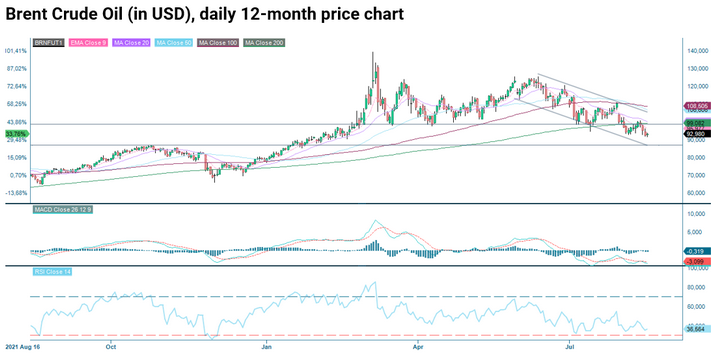A bottom in the oil price – or another leg down?


The oil price has pulled back considerably from the highs at the beginning of the summer. Despite a tight supply situation and the ongoing energy crisis in Europe, fears of an economic slowdown in the US, as well as China, is now a prevailing theme in metal and energy markets.
The oil price has pulled back considerably from the highs at the beginning of the summer. Despite a tight supply situation and the ongoing energy crisis in Europe, fears of an economic slowdown in the US, as well as China, is now a prevailing theme in metal and energy markets.
The relation between interest rates (in the chart below: 10 year US yield) and the oil price is surprisingly strong. However, the recent pick-up in rates has only had a limited impact on oil. Possible explanations are a recent build in inventory and some short-term headwinds from increasing real yields and a stronger US dollar.
Interest rate vs. oil price

However, the tight supply means that prices are sensitive to sudden shocks (e.g., lower Russian exports, Hurricane season) which risk could be driving prices higher in the coming months. Also, in Europe, oil might serve (albeit only partly) as a substitute for expensive natural gas. Since the Biden administration is trying to push down oil prices in the US ahead of the mid-term elections in November, through the release of strategic petroleum reserves, we would focus on Brent oil.
From a technical perspective, the oil price is in a negative trend below MA 200 which likely means continued volatility in the near term. Nevertheless, there might be a bounce from the USD 92-93 per barrel level if these recent bottoms should hold. The five-year chart also suggests Brent could find support around these levels. The USD 100 level is a natural first target.

However, the price action has been decidedly negative in recent days and bulls would need to see prices rebound soon. In a negative scenario where the price breaks down further, the charts suggest a downside to USD 85 per barrel.

Bull & Bear-Certificates
The full name for abbreviations used in the previous text:
EMA 9: 9-day exponential moving average
Fibonacci: There are several Fibonacci lines used in technical analysis.
Fibonacci numbers are a sequence of numbers in which each successive number is
the sum of the two previous numbers.
MA20: 20-day moving average
MA50: 50-day moving average
MA100: 100-day moving average
MA200: 200-day moving average
MACD: Moving average convergence divergence
Risks
This information is neither an investment advice
nor an investment or investment strategy recommendation, but advertisement. The
complete information on the trading products (securities) mentioned herein, in
particular the structure and risks associated with an investment, are described
in the base prospectus, together with any supplements, as well as the final
terms. The base prospectus and final terms constitute the solely binding sales
documents for the securities and are available under the product links. It is
recommended that potential investors read these documents before making any
investment decision. The documents and the key information document are
published on the website of the issuer, Vontobel Financial Products GmbH,
Bockenheimer Landstrasse 24, 60323 Frankfurt am Main, Germany, on
prospectus.vontobel.com and are available from the issuer free of charge. The
approval of the prospectus should not be understood as an endorsement of the
securities. The securities are products that are not simple and may be
difficult to understand. This information includes or relates to figures
of past performance. Past performance is not a reliable indicator of future results.